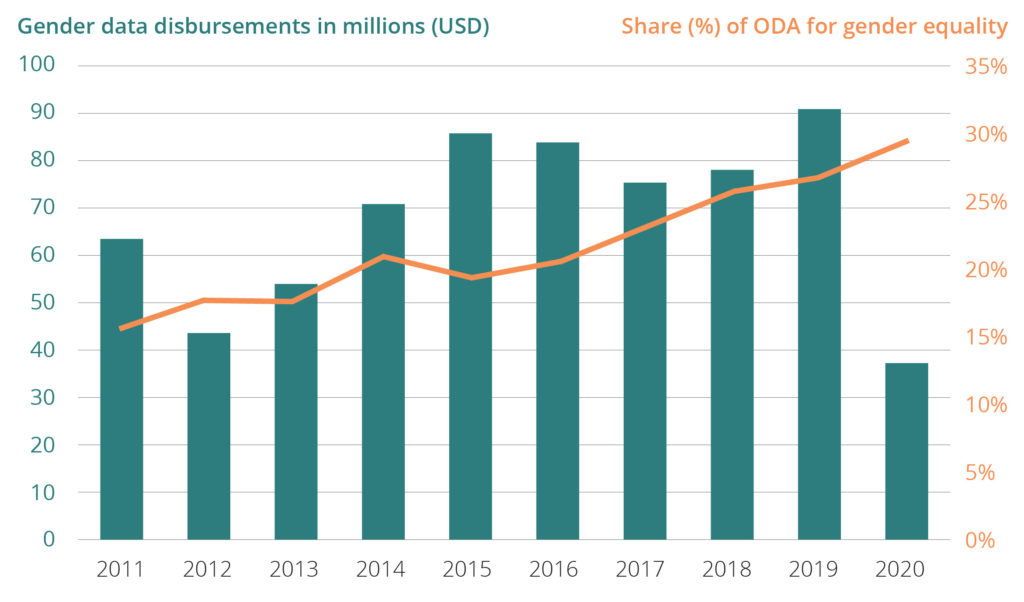Achieving the gender equality ambitions of the Sustainable Development Goals (SDGs) requires strong gender data systems to measure and implement gender-transformative policies—but financing for gender data has not kept pace with demand.
Funding for gender data decreased by 55 percent in 2020—nearly three times the drop in funding to overall data and statistics.
This comes despite widespread recognition of gender data as a critical input to achieving gender equality goals. While funding for gender equality programs reached a new high in 2020, there has been no corresponding increase in funding for gender data and statistics.

These figures come from “The PARIS21 Partner Report on Support to Statistics 2022 – A Wake-Up Call to Finance Better Data”—the most comprehensive annual analysis of donor financial flows to data and statistics. The report raises the alarm on the widening financing gap for data and statistics, particularly for gender data.
The concentration of funding among a limited pool of donors, the disruption of data collection due to the COVID-19 pandemic, the impact of competing crises on donor and national government budgets, and the historical lack of mainstreaming support for gender data can all explain the decline in financing for gender data, but do they excuse them?
A chronic under-resourcing of core gender data systems perpetuates a vicious cycle of persistent gender data gaps
Delivering on the promise of the SDGs requires robust gender data systems that can only be established through smarter and more sustainable investments.
Previous investments, though vital to existing gender data, have not met the requirements for robust gender data systems: Between 2015 and 2020, donors and governments fell short of required investments in survey and administrative data systems by $2.7 billion. This shortfall affected time-use surveys in particular, with barely 1 percent of required funding allocated. With these funding trends in mind, it is no surprise that the world is woefully off-track to generate enough gender data: According to UN Women, current trends suggest that it will take another 22 years to fill SDG gender data gaps.
Untapped potential for gender equality
The benefits of sustained gender data financing reach across sectors: It would enable regular monitoring and means to fight gender-biased violence through timely and actionable insights. Better gender data helps to accurately count and improve women’s role in labor force and contributions to economic growth. Women’s contributions to household income and activities would be more accurately captured through time use surveys while strong civil registration and vital statistics systems would ensure every birth, marriage, and death is counted. Improving core gender data systems helps to improve the overall data systems in a country for all—not just for women and girls. The whole society will gain from investments to build a better gender data system.
As momentum builds towards the SDG Summit in Fall 2023—the halfway point for the SDGs—ongoing initiatives for smarter gender data financing can help lead the way. The upcoming Effective Development Cooperation Summit hosted by the Global Partnership for Effective Development Cooperation on 12-14 December will highlight the importance of financing for statistics and a call to action issued for donors to support statistical systems.
A path towards sustainable gender data systems
Gender-sensitive and inclusive data ecosystems are not achieved by one event, institution, or country alone; it requires collaboration, partnerships, and knowledge sharing. That’s why Data2X, in partnership with Open Data Watch, has identified gender data financing as a priority for its work program going forward. We are working on several fronts, including partnership, research, and advocacy, to reverse the downward trend for gender data financing and accelerate progress towards the gender equality agenda:
- Emphasizing the importance of domestic resource mobilization: Domestic resource mobilization is the most sustainable path for building an effective gender data infrastructure. To build a sustainable gender data financing environment, the first step is for NSOs to clearly articulate demand and budget for gender data in national statistical plans, providing an over-arching framework for engagement with planning ministries and development partners. We will be harnessing the Gender Data Network, alongside forthcoming, innovative tools, to support these efforts.
- Mainstreaming gender data into national plans for gender equality: While strategic planning and coordination by the NSO can support implementing system-wide improvements, demand for better gender statistics should come from outside the NSO as well. Other public agencies and ministries should look to integrate gender-oriented goals into their own budget policies, programs and processes, and specifically outline the role data will play in achieving them. The reality that funding for gender equality is on the rise while gender data is on the decline demonstrates the need to harmonize the two agendas. We aim to monitor and report on progress, specifically identifying leaders in the field that can serve as good practices for others.
- Leveraging existing funds to close the gender data financing gap: While the goal should be to see countries fully financing their national gender data systems, this isn’t always possible – especially in resource-constrained environments. Rethinking how existing funds can better support investment in gender data represents a further important complement to country-led efforts. More research to identify opportunities and strong advocacy to make the case for solutions is needed; we plan to fill that gap.
- Harnessing the power of transparency to strengthen systems: A better understanding of where donors are active coupled with what the priorities are at the country-level can lead to smarter gender data finance. Using the Gender Data Channel of the Clearinghouse for Financing Development, we will dig deep into the supply and demand of funding to collectively build better gender data systems.
Join us in the efforts to increase gender data financing and improve the lives of women and girls around the world.
This article is the first in a 3-part series on gender data financing.
